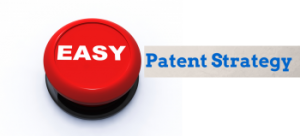That title got your attention, didn’t it? It was meant to. After another successful round of patent application examinations for several clients in the last year, I thought others would like access to my proven patent acquisition methodology. Certainly, there’s a lot more than I can include in this post, and what is presented here should be considered to be only a high level introduction to my process. Moreover, every client requires focused attention to generate the desired patent protection, and not every business scenario mandates this comprehensive approach. But, for those situations where company leadership determines that strong patent protection is a key to achieving the desired business outcomes from investment in innovative products and technology, this methodology is not only recommended, it is required for success. Put simply, if you do the hard work on the front end as outlined in this post, it is more likely that
Want Broad, Meaningful Patent Protection Fast? Use These 3 Steps
Value Enhancing Patent Prosecution Strategies: Non-Publication of US Applications
The non-publication procedure for certain US patent applications is one of the most under-utilized tools in the U.S. patent strategy toolkit. After 20+ years of experience as a patent attorney, the non-publication process is one of my go-to strategies for clients who wish to start the process of patenting their innovations without also prematurely disclosing their “secret sauce” to their competitors, as would normally be the case when filing a patent application that will publish in 18 months after filing if the standard application process is selected.

In addition to allowing the information in a patent application to remain confidential from prying eyes for a longer time, this can strategy
Value Enhancing Patent Strategies: Accelerated US and Foreign Patent Timelines
My many years of experience as an IP Strategist working with countless clients helps me hone keenly my effort to assist clients in utilizing various patent strategies available to them, including how to buck the trend of long patent pendency that can create business uncertainties. In this regard, you probably know the traditional patent acquisition timeline is typically 2.5-4 (or even more) years from US utility application filing to issuance. For clients seeking protection outside the US, the time can be twice as long.

The time for obtaining US and non-US applications can be greatly reduced through use of acceleration techniques made available in recent years. I have obtained dozens of US utility applications for clients using the “Trackone”
Value-Enhancing Patent Prosecution Strategies (Part 1 of 3)
 In my role as the IP Strategist for a number of companies that do not employ in-house patent counsel, I am charged with making sure that my clients’ patenting efforts are in tune with their desired business outcomes. This means that instead of focusing on the drafting and prosecuting of patent applications that form the basis of most patent attorneys’ practices, I work at the front end of the patenting process to design patent strategies that will enhance my clients’ business value first and foremost. When alignment is created with business goals, subsequent patenting efforts will necessarily result in protection that matters to the value of the company. In this regard, I have a number of tools in my “Patent Strategy Toolbox” that I deploy regularly when developing patent prosecution recommendations. Notably, when I mention these tools to new clients, I
In my role as the IP Strategist for a number of companies that do not employ in-house patent counsel, I am charged with making sure that my clients’ patenting efforts are in tune with their desired business outcomes. This means that instead of focusing on the drafting and prosecuting of patent applications that form the basis of most patent attorneys’ practices, I work at the front end of the patenting process to design patent strategies that will enhance my clients’ business value first and foremost. When alignment is created with business goals, subsequent patenting efforts will necessarily result in protection that matters to the value of the company. In this regard, I have a number of tools in my “Patent Strategy Toolbox” that I deploy regularly when developing patent prosecution recommendations. Notably, when I mention these tools to new clients, I
IP Strategy is Increasing Focus at Innovative Companies: Here’s Why
After more than 8 years, I can report that IP Strategy is an increasing focus at innovative companies, and there is a solid reason why this is so. By way of background, for many years, I have been part of a small minority of IP experts who advocate that companies desiring to maximize the value of their IP investments re-think the way they seek and obtain patents. In short, I and my IP Strategist peers urge companies to wrest control of their “IP destiny” from their legal service providers who have traditionally been seen as the primary drivers of the patenting process for their clients.

Of course, readers
10 Key IP Strategy Insights for Innovative Companies for 2016 and Beyond
As 2016 begins, I am entering my 8th year(!) of writing about IP strategy insights from a business value creation perspective, both here on my IPMaximizerBlog.com and, more recently, on LinkedIn.
While there were quite a few IP lawyers writing blogs in 2008, no one else was then writing about IP strategy.

Today, there are even more IP lawyers writing blogs about IP law, but still almost none writing that address IP strategy topics that are meaningful outside of the IP monetization and large IP
“IP Strategy” is Meaningless without Desired Business Outcomes
"You can't sell me IP Strategy, Jackie," one of my top clients said to me recently when I sat down with him to conduct customer discovery for my IP Strategy practice. This client, a successful serial entrepreneur whose company has engaged me as "fractional Chief IP Counsel" for the last 1.5 years, swears by the services I provide to him--so much so, that he is a primary source of startup entrepreneur referrals that I obtain today. I was thus surprised that he didn't see my value as providing him with "IP Strategy," but as something else entirely. He said: "If I had to go on the record of why I value your expertise, it's because IP is important to my exit, and you look at IP differently than any other lawyer I have known. I know you're focused on creating value for my startup, so I want to keep you
Why Business Fails to Generate Patenting Strategies that Protect Innovation Value & How to Make It Easier
Business leaders often find the decision of whether to obtain patent protection for their company's innovations to be difficult. Of course, conventional wisdom, not to mention legions of patent attorneys, assert that patents are "important" to "protect" one's business. In my experience, however, few business people can clearly articulate specifically why and to what extent patents can and will create real financial value for their business.

This means that, in many companies, the decision to obtain (or not obtain) patent protection in a particular situation comes down to evaluation of anecdotal information from which a "business judgment" is formulated. In my view, when based only on anecdotes, as opposed to real
Companies Create Risk by Leaving IP Strategy Out of Innovation
I recently had to give bad news to a new client, the CEO of a successful global electronic hardware company. This CEO hired me earlier this year to help ensure that his company's upcoming innovations, which were the product of a several year turnaround program, were protected from competitive knock-offs. I have completed a couple of projects for the company to date, and he now wanted to discuss IP protection for a new product for the European market that would serve as a platform for later product spin-offs both there and in the US.

This new product incorporated a number of highly innovative features and almost certainly could generate broad patent
Lack of Focus on IP Strategy Destroys $100 Millions in Value
 As an IP Strategist, I am fascinated by stories from which declining business fortunes can be traced directly to failed patent strategies. Often, the failures can be traced to patent attorney errors that limit the effectiveness of a company's patent to prevent competitive knock-offs, but, often, the problems can be traced to the lack of accountability for IP strategy within an organization. For those companies where IP is a primary driver of competitive advantage, the absence of someone who "owns" the job of making sure IP is properly captured and protected can result in unrecoverable errors that opens the innovator to unwelcome competition. In this regard, the recent loss of patent protection to a popular drug product should serve as a useful case study on why the C-suites of innovative companies should consider strategic in-house IP counseling to be a
As an IP Strategist, I am fascinated by stories from which declining business fortunes can be traced directly to failed patent strategies. Often, the failures can be traced to patent attorney errors that limit the effectiveness of a company's patent to prevent competitive knock-offs, but, often, the problems can be traced to the lack of accountability for IP strategy within an organization. For those companies where IP is a primary driver of competitive advantage, the absence of someone who "owns" the job of making sure IP is properly captured and protected can result in unrecoverable errors that opens the innovator to unwelcome competition. In this regard, the recent loss of patent protection to a popular drug product should serve as a useful case study on why the C-suites of innovative companies should consider strategic in-house IP counseling to be a


